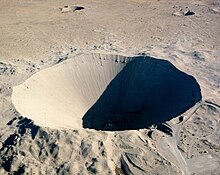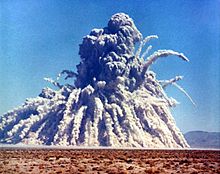Civil nuclear explosive device
In addition to their military importance, nuclear weapons could also be used for civilian purposes. Both the United States of America (" Operation Plowshare ") and the Soviet Union ( nuclear explosions for the national economy ) made numerous attempts to make raw material deposits more abundant through underground nuclear explosions , as well as in construction, especially in canal construction. All imagined civil application areas turned out to be impractical due to the high level of radioactivity and contamination.
Crater-creating explosions
The best- known example of a civilian atom bomb is the so-called Sedan explosion in the USA on July 6, 1962. With an explosion force of 100 kt TNT equivalent , a crater with a diameter of 390 m and a depth of 98 m was excavated. In a Soviet experiment, three nuclear charges, each with 15 kt TNT equivalent, were detonated at a distance of about 165 m and at a depth of 127 m. This created an elongated crater 700 m long and 10 to 15 m deep on the route of the Pechora-Kolva Canal . Other US atomic bomb explosions to create craters were the Danny Boy , Sulky , Cabriolet , Buggy and Schooner experiments . In crater-producing explosions, the atomic explosive device is detonated underground, but at such a shallow depth that the explosion penetrates to the surface of the earth and distributes a large amount of rock into the surrounding area.
Extraction of raw materials
In the completely underground US test explosions Gasbuggy on December 10, 1967 with 28 kT explosive force, Rulison on September 10, 1969 with 43 kT explosive force and Rio Blanco on May 17, 1973 with three atomic bombs of 33 kT each, the effects of underground atomic bomb explosions were on natural gas reservoirs examined. The aim was, in particular, to increase the productivity of the gas deposits by loosening the rock.
Although the Rulison test in particular was very successful (the yield of the gas was increased by a factor of ten), the natural gas obtained in this way could hardly be sold despite the very low level of radioactive contamination.
The Australian mining magnate Gina Rinehart caused a sensation with demands to be allowed to exploit her mines by means of nuclear explosions.
Caverns
Underground atomic bomb explosions create large cavities if the depth, the nature of the ground and the explosive power are appropriate. Based on this, there were plans to create caverns for example for underground oil storage, gas storage or for the permanent storage of waste materials.
Combating oil and gas spills
In the course of attempts to bring the oil spill in the Gulf of Mexico under control in 2010 , the proposal to use a nuclear explosive device to combat the oil spill came to the fore. According to Russian media reports, this method was used repeatedly in the former Soviet Union to combat uncontrollable gas leaks. The atom bomb explosion is said to have caused the rock surrounding the borehole to melt due to the enormous heat, thereby closing the leak. Steven Chu , Secretary of the United States Department of Energy (DOE), and other members of the government, in response to this and various other reports in the media, said that the use of an atomic bomb to plug the oil leak had never been considered by the authorities.
Use for earthmoving
There were plans to use atomic bombs to blow up bays in rocky coasts, which would then be used as deep water harbors, see also Operation Chariot .
For pioneering work in general, nuclear detonations can be used. Because of their great strength, they would reduce the workload considerably.
Generation of seismic depth profiles
Nuclear explosions can be used to generate seismic depth profiles. The advantage over the generation with conventional blasting or vibrating machines lies in the significantly higher explosive force, which generates stronger sound waves and thus enables the creation of larger (several thousand kilometers) and deeper seismic profiles. In the 1970s in the Soviet Union, as part of the “Russian Deep Seismic Sounding” program, several civilian nuclear explosive devices were detonated to obtain seismic data.
Nuclear pulse engine
Another possible civil application would be spaceships with nuclear pulse propulsion . In the 1950s and 1960s there was the Orion Project in the USA , the aim of which was to construct such a spaceship powered by atom bomb explosions. However, the project was discontinued in 1965 without any nuclear explosion testing.
In 1978 scientists from the British Interplanetary Society published their draft for the Daedalus project : an unmanned research spaceship was supposed to fly to Barnard's star 6 light years away with the help of pulsed nuclear fusion explosions within 50 years .
Deflection of asteroids
Large asteroids or comets represent a great danger to life on earth due to their enormous impact energy if they are on a collision course with the earth. The extinction of the dinosaurs is generally attributed to such a cosmic catastrophe at the time of the Cretaceous-Tertiary boundary . If such an object is discovered in time, there could be an opportunity to distract it. A change in speed of only 5 cm per second (corresponding to 0.18 km / h) causes a course deviation of over 15,000 km in 10 years, i.e. more than the diameter of the earth. Due to the high mass of large asteroids, however, a large amount of energy is required even for such a small change in speed. An atomic bomb could do this by detonating it near the asteroid. The released radiation vaporizes material from the surface of the asteroid, which also causes the asteroid to recoil in the opposite direction.
What is critical about this process is that the size and direction of the recoil can only be roughly predicted before the deflection is carried out. The problems start with the nuclear explosive device itself, the explosive force of which fluctuates depending on when exactly after the establishment of supercriticality the first neutrons trigger the chain reaction. The energy transfer to the asteroid or comet can also not be precisely predicted, as this could be the case. a. depends on the degree of absorption and the structure of the surface. The chemical composition then determines how much material is then evaporated and how high the gas pressure is.
With a sufficiently long advance warning time before the possible impact, it therefore generally appears more promising, more precise methods, such as B. large parabolic mirrors in space to use. In the event that there is little time left until the impact or very high masses to be deflected, however, the diversion by nuclear explosion is probably the only currently technologically available alternative. On the other hand, it is usually impractical to blow up the asteroid itself, as is shown in some Hollywood films, since the individual asteroid parts would be uncontrollable and would likely cause much greater damage to the earth.
hazards
The civilian explosions generated comparatively large amounts of radioactive contamination away from the well-known nuclear weapons test sites . Radioactive substances are introduced into the atmosphere and into the rock, which is why these applications are now generally viewed as too dangerous and too polluting. In addition, there is an extremely high risk of proliferation in all of the applications shown here , as the atomic explosives intended for civil purposes could be misused for military purposes at any time.
See also
Remarks
- ↑ Archive link ( Memento from June 3, 2013 in the Internet Archive )
- ↑ Article Нефтяную течь в Мексиканском заливе можно ликвидировать ядерным взрывом of May 3, 2010 in Pravda (Russian)
- ↑ Article Nuclear Option on Gulf Oil Spill? No Way, US Says , in: New York Times, June 3, 2010
- ↑ Igor Morozov, Elena Morozova: Russian Deep Seismic Sounding Data ( Memento of March 8, 2012 in the Internet Archive ), UWyo Seismology Group, University of Wyoming (English)

